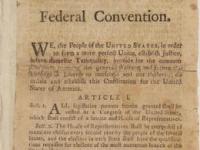

Though the Preamble holds no legal powers within the Constitutional context, it does provide the interpretive framework for understanding this founding document. By using such phrases as “We the People,” the Preamble makes clear that the power of government comes from the people and is accountable to the people, firmly establishing the concept of Popular Sovereignty. It also establishes the purpose and ambition of the Constitution to create “a more perfect union” than those governmental bodies that have come before.
Students who can decode the language of the Preamble will be able to contextualize the U.S. Constitution and formulate a deeper understanding of both the ideas and principles behind it. In this lesson, the students will read and then synthesize the Preamble into their own words. Then they will compare and contrast an earlier version of the Preamble to the final version to gain an understanding of how the language of the Preamble changed to better align with such founding principles as Popular Sovereignty and Federalism.
Students will be able to:
Prior Knowledge:
Students should be familiar with the seven principles of the Constitution: Popular Sovereignty, Republicanism, Limited Government, Federalism, Separation of Powers, Checks and Balances, and Individual Rights. The two main principles this lesson will focus on are “Popular Sovereignty” and “Federalism.”
Part A: Preamble in Your Own Words
1. The teacher will open class by asking if the students know the opening words of the U.S. Constitution. This question should lead into a larger discussion where the teacher can talk about what a Preamble is and why it is important to the U.S. Constitution.
2. Students should get into pairs, and the teacher will hand out the worksheet.
3. Explain to the students that they will be reading the Preamble and putting it into their own words (creativity is welcome).
a. The left side of the worksheet contains the Preamble (split up into different sections) with questions that should be answered) and the right side of the worksheet is where they will put this document into their own words.
b. Teacher should model the first box, “We the People.”
4. Once students have completed the activity, they should share what they have written with the rest of the class.
a. Teacher may guide this part of the lesson into identifying larger themes the students picked out from reading, i.e. popular sovereignty and federalism.
Part B: Comparing and Contrasting Two Versions of the Preamble
1. Display or handout the Wilson draft of the Preamble of the Constitution and explain to the students:
a. For this next part of the activity, we will be comparing and contrasting a draft of the Preamble to the final version to gain a better understanding of why language matters and how words can represent larger concepts and meanings.
b. This version recorded by James Wilson, Representative from Pennsylvania to the Constitutional Convention, during the “Committee of Detail” sessions. This committee was formed to produce a draft of the Constitution that would be presented to the Constitutional Convention for final revisions and eventual ratification.
2. Give the students a few minutes to read the draft and then have one of them read it out loud. Ask the students to turn to their partner:
a. What stands out the most to them about this version of the Preamble?
i. Have student share.
b. Have the students underline the parts of the Preamble that are different on their worksheet.
c. What's the biggest difference between the two versions? Why do you think the Framers changed that part?
i. Have students share.
d. This type of discussion should get the students ready for the next five questions on the worksheet.
3. Tell the students you want them to work in pairs to answer the next five questions in complete sentences.
4. After the students have had some time to respond to the questions, go through each one and have the students provide the answer. This should lead into a larger discussion concerning each issue.
a. For question ‘1’: The main theme should be unity between the states and power coming from the people, not from the states, as expressed by “We the People.”
b. For question ‘2’: The main theme should be the framework and structure the final version provides in connection to the purpose of the Constitution. Students should also make the observation of how that detail is missing from the older draft.
c. For question ‘3’: The main theme should be “We the people” as it relates to popular sovereignty.
d. For question ‘4’: The main theme should focus on the fact that naming the states individually in the Preamble implies the power of government comes from the states, not the people. It also provides the framework for a weaker federal government (federalism).
e. For question ‘5’: The main theme should be “a more perfect union” and the idea of federalism or a federal government providing the framework and structure for this union of shared power.
Exit Ticket:
1. What is the single most important change the Founders made to the Preamble and why?
2. What is the purpose of the Preamble to the United States Constitution?
![]()
The Preamble in Your Own Words.pdf
![]()
Why Words Matter - Preamble.pdf
![]()
Wilson 1787 Draft of the Preamble.pdf